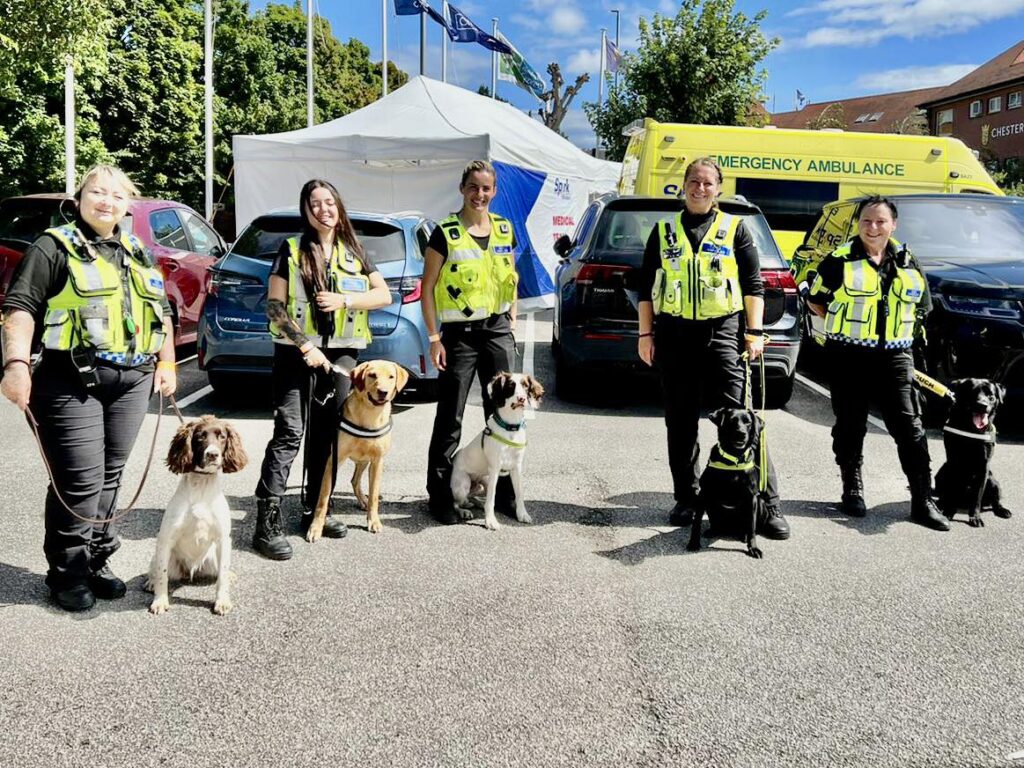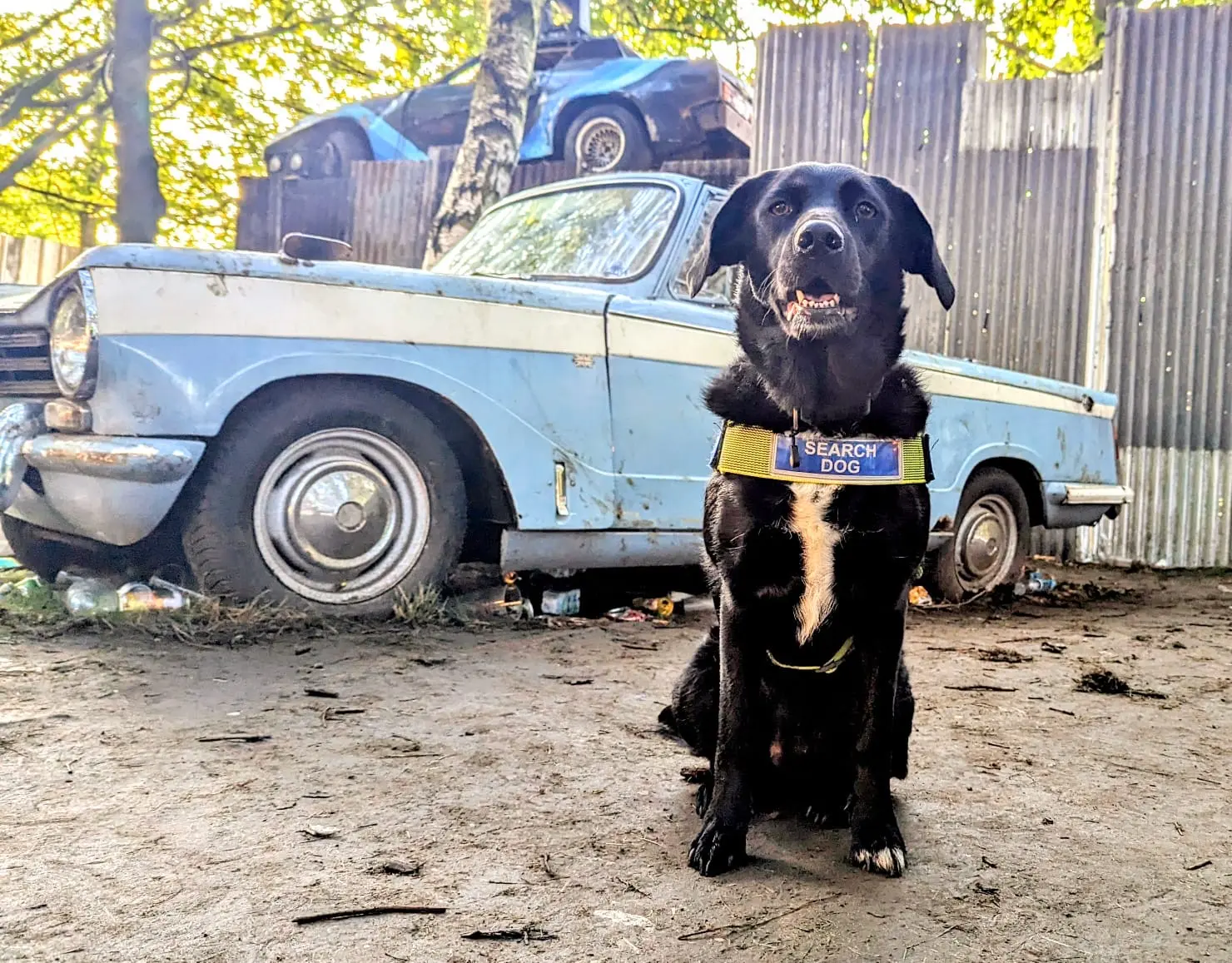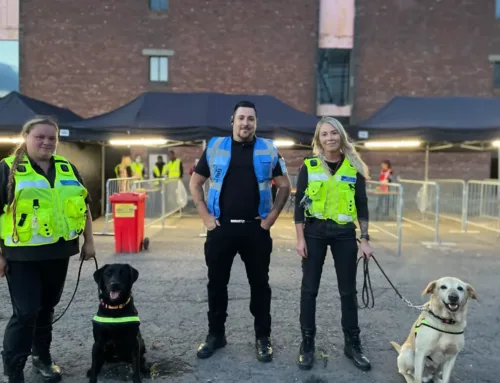Detection dogs are invaluable assets in the world of security, events and law enforcement, where the stakes are high and the margin for error is small. These specially trained canines possess an extraordinary ability to sniff out a variety of substances, ranging from illegal drugs to explosive materials, which makes them a critical component in the enforcement of laws and the protection of public safety. Their keen sense of smell, unmatched by any human-made technology, allows them to detect odours in trace amounts that would otherwise go unnoticed.
The capabilities of detection dogs extend beyond just identifying these dangerous substances; they also play a pivotal role in deterring criminal activities. With their presence at airports, border crossings, and public events, detection dogs serve as a visible and psychological deterrent to those who might otherwise attempt to transport or use illicit substances.
Their contributions to safety are vast and multifaceted. Detection dogs are trained to work in various environments, whether it be scanning luggage at bustling airports, conducting searches in buildings, or patrolling large venues. Their agility and training enable them to navigate dense crowds and confined spaces, where they discreetly screen for the scents they have been trained to detect.
These dogs do not solely rely on the presence of actual substances; their sensitive noses are also capable of picking up residual odours left behind by drugs or explosives, which can lead to the uncovering of past or planned illegal activities. This high level of accuracy in identifying such a wide range of substances makes detection dogs an essential tool for law enforcement agencies and security professionals worldwide.
The use of detection dogs is a testament to the unique relationship between human handlers and their canine partners, bringing together instincts, training, and technology in a powerful alliance against crime and threats to public safety. As we continue to face challenges in security, the role of detection dogs remains not only relevant but indispensable, adapting to new threats and reinforcing our collective safety with each sniff.
Canine Olfactory Biology
The canine olfactory system is a marvel of biological engineering, granting dogs their renowned status as the gold standard in scent detection. At the forefront of this system is the anatomy of a dog’s nose, which is vastly different from that of humans. A dog’s nose is equipped with a complex network of up to 300 million olfactory receptors, compared to a mere 5 to 6 million in humans. This abundance of receptors not only allows dogs to detect odours at incredibly low concentrations but also enables them to distinguish between a wide variety of different scents.
The internal structure of a dog’s nose further enhances its smelling capabilities. Dogs have a specialised tissue called the olfactory epithelium, which has a much larger surface area than that found in humans, providing more space for scent molecules to bind to receptors. Additionally, the slits on the sides of a dog’s nose allow them to take in new scents while simultaneously exhaling, creating a continuous flow of air over the olfactory receptors.
Once a scent molecule binds to these receptors, it triggers a signal that is sent to the olfactory bulb, the brain’s initial point of processing for olfactory information. The olfactory bulb in dogs is proportionally much larger than in humans, accounting for a greater part of their brain’s total mass. This allows dogs to process and interpret complex smells far more efficiently than their human counterparts.
Beyond the olfactory bulb lies the olfactory cortex, where the interpretation of scents occurs. This region of the brain deciphers the information received from the olfactory bulb, differentiating between thousands of different smells, and helps to determine the significance of each scent. The olfactory cortex is key in enabling dogs to not only detect odours but also to remember them, which is crucial for tasks such as tracking and identifying specific substances.
The overall design of canine olfactory biology, from the specialised structures in their noses to the intricacy of their brains, is what underpins their exceptional scent detection abilities. Understanding the science behind this enables handlers and trainers to maximise the use of detection dogs in various security scenarios, leveraging their natural abilities to maintain and enhance safety measures.
The Mechanics of Scent Detection
The mechanics of scent detection in canines are governed by a sophisticated interplay between the physical properties of odours and the sensory capabilities of the dog. Scent, at its core, is composed of chemical compounds that disperse into the air and can be detected by receptors. Dogs perceive these scents through their highly evolved olfactory system, which can identify and differentiate between an incredible range of individual components within a complex odour.
When a substance emits an odour, it does not do so uniformly in all directions. Instead, the scent molecules create a “scent cone,” a three-dimensional, cone-shaped pattern of scent dispersion that broadens with distance from the source. The shape and reach of this cone are influenced by various environmental factors such as wind direction, speed, temperature, and humidity. These can carry and dilute scents, making the skill of the detection dog in interpreting the cone’s edge crucial for locating the source of the odour.
Dog handlers must therefore be adept at reading these environmental cues and understanding how they alter the scent picture that their canine partners are presented with. For example, on a hot day, thermal currents can lift scents off the ground, making them harder to track, whereas on cooler days, scents may linger closer to the surface.
The threshold of detection is another critical aspect of the mechanics of scent detection. It refers to the minimum concentration of odour molecules that a dog’s nose can detect. Canines have an incredibly low threshold for scent detection, which enables them to pick up odours that are imperceptible to humans and most technological devices. This sensitivity allows them to locate the source of a scent with remarkable accuracy even when the target substance is present in only minute quantities or is masked by other odours.
Through rigorous training, detection dogs learn to identify specific scents and give a trained indication (such as sitting, barking, or signalling with their nose) when they detect the target odour. The efficiency of this process hinges on the synergy between the dog’s natural detection threshold and the trainer’s understanding of scent mechanics, which together enable the dog to perform its duties with extraordinary precision.
Grasping the mechanics of scent detection is not only fascinating from a scientific perspective but also critical for optimising the deployment of detection dogs in the field, where their skills in navigating the intricate world of scents play an essential role in safeguarding public security.
Training and Conditioning
The journey of a detection dog from a playful pup to a disciplined security asset is marked by a meticulous selection and training process. Not all dogs are cut out for detection work; it requires a specific blend of traits such as high drive, mental acuity, and a stable temperament. Breeds such as Spaniels, German Shepherds, Belgian Malinois, and Labrador Retrievers are often chosen for their innate abilities and trainability. The selection process typically involves assessing the dogs’ behaviour, responses to stimuli, and willingness to work for rewards, whether it’s a favourite toy or a treat.
Once selected, the foundational stage of training begins. It is here that the dogs are socialised to a variety of environments and sounds, which helps to minimise distractions and potential stressors during active duty. The next phase focuses on imprinting the target scents. Dogs are exposed to the specific odours they will be tasked with detecting, and through repetition and reward-based training, they learn to associate the scent with a positive outcome. This conditioning forms the basis of their future responses when locating these substances in real-world scenarios.
To enhance a dog’s natural abilities, trainers employ various techniques that leverage each dog’s intrinsic drive and curiosity. One such method is the use of a “scent wall,” where target odours are placed in a lineup of identical canisters, and the dog must discern and indicate which canister contains the odour. Another technique is “buried hides,” where odours are concealed underground or within structures to emulate real search environments.
Ongoing training and reinforcement are critical to maintaining and improving a detection dog’s abilities. This includes regular exposure to the target scents in various contexts and continuous positive reinforcement to keep the dogs motivated and responsive. Scenario-based training exercises, where realistic search situations are simulated, are also crucial. These can include searching vehicles, buildings, luggage, or open areas, which helps to ensure that the dog’s skills remain sharp and adaptable to different operational needs.
Advanced training may also involve exposing the dog to complex scent pictures, where non-target odours are introduced to challenge the dog’s discrimination abilities. It’s a way to prepare them for the unpredictable nature of real-life searches where distracting scents are commonplace.
Regular assessments and performance evaluations ensure that standards are upheld, and any behavioural or proficiency issues are addressed promptly. Handlers play a vital role throughout this process, as the bond between handler and dog is a key component to successful training and operational effectiveness.
The training and conditioning of detection dogs are elaborate processes that require a deep understanding of canine behaviour, systematic reinforcement, and consistent practice. This professional development enables detection dogs to perform their duties with exceptional skill, ultimately contributing to the efficacy of security operations conducted by Inquest Detection and our partners.

Modern Applications and Technology
Detection dogs’ abilities are not only timeless but have also found contemporary applications across diverse security fields. Their acute sense of smell and ability to navigate different terrains make them indispensable in settings such as music festivals, corporate events, and retail environments for loss prevention. At these venues, dogs are used for crowd management, as their presence can act both as a deterrent and a rapid-response resource for detecting illegal substances or explosives.
In hospitality and leisure, including exclusive clubs and hotels, canine teams enhance the sense of security and comfort for guests by providing discreet yet effective surveillance. Corporate security also benefits from the presence of detection dogs, especially in scenarios requiring the screening of visitors or monitoring of suspicious packages.
Inquest detection emphasises the importance of effective communication and the use of technology to streamline operations. Communication training, including the use of radios and the development of clear messaging protocols, ensures that canine teams can operate efficiently and are well-integrated into the overall security strategy.
New research into enhancing canine detection capabilities is ongoing, with a focus on understanding the influence of genetic and dietary factors. By selecting breeds with traits conducive to scent work and providing optimal nutrition that supports olfactory function, it is possible to amplify the natural talents of these animals. This research is crucial as it holds the promise of elevating canine performance, thus refining detection work and strengthening security measures.
Inquest Detection stays ahead of such developments and adapts its training and operational procedures accordingly. By blending the instincts and abilities of detection dogs with cutting-edge technology and comprehensive training, the company ensures unparalleled security solutions tailored to each client’s unique needs. Whether it’s property guarding, alarm monitoring, or close protection, the application of canine detection teams continues to be a cornerstone of Inquest’s approach to safety and security.
Ethical and Practical Considerations
Ethical considerations in the use of working dogs are paramount. Handlers must adhere to strict guidelines to ensure that their actions do not compromise the welfare of the dogs or the safety of the public. In situations like bomb threats or suspicious items, handlers must be especially vigilant and report any concerns to supervisors while remaining calm and adhering to protocols, including those outlined in counter-terrorism training.
The limitations and challenges faced by detection dogs and their handlers include staying alert to potential threats without causing undue alarm or disruption. Handlers must be trained to work within robust quality management systems and procedures, ensuring they uphold the high standards expected by clients and the public. Rigorous training is also essential for handlers to maintain professionalism, particularly during high-stress scenarios such as a no-warning terrorist attack.
Approaches to ensuring the well-being of detection dogs in active service are closely linked to the welfare and vulnerability engagement (WAVE) training program. The program equips individuals with the skills to identify and assist those who may be vulnerable or threatened. Handlers must report any hazards or incidents to their managers promptly and follow all directives closely.
It’s essential to apply ethical practices not only to human staff but also to canine members of the security team. This includes providing detection dogs with a safe work environment, regular veterinary care, adequate rest periods, and a nutritious diet tailored to their demanding roles. Handlers are also responsible for recognising and addressing any signs of stress or discomfort in their canine partners, ensuring that they receive proper care and attention throughout their service.
Adhering to the 5 Freedoms of Animal Welfare, Inquest Detection ensures that our dogs are well-cared for and operate within a rigid and robust humane framework. Our commitment to these fundamental freedoms guarantees that our canines are free from hunger and thirst, discomfort, pain, injury, or disease, and are free to express normal behaviour while also feeling safe and protected from fear and distress.
We also maintain compliance with British Standards, reinforcing our commitment to professional, responsible security provision for all of our clients. This adherence to high standards of animal welfare is mirrored in the professional conduct of our services, which is affirmed by our exhaustive list of accreditations, including the Security Industry Authority, UKAS ISO certifications, and the prestigious associations we are members of. This showcases our resolve to excel not only in the ethical treatment of our canine colleagues but also in delivering top-tier security solutions.
Inquest is committed to the ethical treatment of detection dogs and the continuous improvement of their handlers’ skills. By valuing the contributions of these canine teams and recognising their needs, the company upholds its reputation for professionalism and excellence in security services.
Conclusion: A Critical Asset
Detection dogs play an indispensable role in ensuring public and private security. Their unparalleled olfactory abilities make them a critical asset in detecting illicit substances, explosives, and other potential threats. Their presence alone can act as a significant deterrent to criminal activity, while their detection work can often go beyond the capabilities of modern technology.
Looking to the future, the use of detection dogs is expected to remain a mainstay in the security landscape, even as technological advancements continue to evolve. These advancements will likely complement and enhance the work of canine teams, rather than replace them. For example, the development of AI and machine learning can provide additional layers of security by integrating canine detection with data analysis and predictive modelling. However, technology cannot replicate the dynamic judgment and intuition of a well-trained dog and its handler.
The symbiotic relationship between humans and dogs in the quest for safety is both profound and ancient. It is built on mutual respect, trust, and a shared goal of safeguarding communities. As societal threats become more complex, the bond between handlers and their canine partners becomes even more vital. Detection dogs are not just tools of security; they are sentient beings that deserve care, respect, and admiration for their work.
The union between humans and detection dogs epitomises a partnership that has stood the test of time and continues to adapt to meet modern challenges. It is a relationship that Inquest Detection honours and champions in its commitment to excellence in security measures, acknowledging the unique contributions that these loyal canines make to our collective well-being. As we move forward, we remain dedicated to the advancement of our security practices, the health and welfare of our canine colleagues, and the protection of the communities we serve.
If you think your event, organisation, business or venue could benefit from the heightened capabilities of a canine team, then please feel free to get in touch. We’re always happy to answer any questions you may have.




